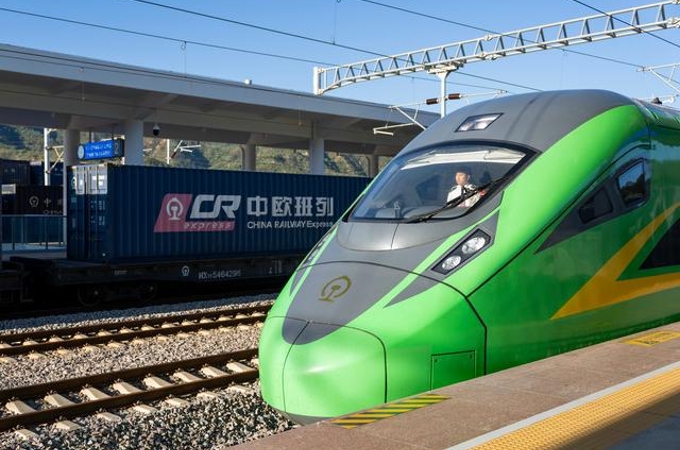Experts: China-Laos Railway is to power Laos' economy
Source: CGTN | 2021-12-01 | Editor:Ines
A trial run of the Chinese section of the China-Laos Railway starting from Kunming, southwest China's Yunnan Province, November 26, 2021.
The soon-to-open China-Laos Railway will establish a rapid transit and commercial link between the Southeast Asian country and the world's second largest economy, powering Laos' economic growth, experts said.
Stretching from Kunming in southwest China's Yunnan Province to the capital of Laos, Vientiane, the 1,000-plus-kilometer electrified passenger and cargo railway will open to traffic in early December.
With a designated speed of 160 kilometers per hour, the travel time from Vientiane to the China-Laos border will be shortened from two days to three hours, and the journey to Kunming can be done overnight, according to China's Xinhua News Agency.
The high-speed railway "could provide Laos with a land link to global and regional supply chains, which could make the country more attractive to investors, create new jobs, and accelerate economic growth," the World Bank said in a 2020 report on the railway's connectivity potential.
As part of the Belt and Road Initiative (BRI), the railway connects Laos with "not only China, but also the entire BRI network," according to the World Bank. It will benefit Laos "through spillover effects from investments in all other connected BRI corridors," the World Bank said.
Laos is surrounded by mountainous terrain and lacks seaports. Its trade routes were through a road and rail to Thailand and four roads to Vietnam, which were aging and time consuming, according to Tom Fowdy, a British political and international relations analyst.
"Hopefully, it will allow this land-locked country to become an exporting and manufacturing powerhouse," Fowdy wrote in an opinion article to China.org.cn.
He said it is expected to provide Laos with a gateway to the rest of China through Kunming, ensuring the land-locked country with access to a huge market beyond its traditional partners, as well as offering more opportunities for its goods to reach the rest of the world through China.
China has already been Laos' largest export destination and largest foreign investor, according to Xinhua. Laos has earned hundreds of millions of U.S. dollars through exports of copper ore, copper and copper products, as well as agricultural products to China every year.
The railway is expected to increase trade flows between China and Laos to 3.7 million tonnes by 2030, while the transit trade through Laos along the railway corridor could reach an estimated 3.9 million tonnes per year by 2030, according to the World Bank.
It could attract traffic that is currently using maritime and air transport routes and significantly reduce land transport costs by 40-50 percent between Vientiane and Kunming, with a reduction of about $30 per tonne, the World Bank said.
As a result, the World Bank predicted that by 2030, 2 million tonnes of trade between China and Laos would shift from maritime transport to the railway, and 1.5 million tonnes of trade through Laos along the railway would see the same shift.
A significant reduction in transport costs will also offer opportunities for existing and new firms to access global value chains and participate in distribution networks, making Laos more attractive to investors, the World Bank said.
Tourism in Laos will be a big beneficiary as well, with hotels, guesthouses, restaurants and vehicle rental businesses expected to earn more, according to Daovone Phachanthavong, vice executive president of the Lao National Chamber of Commerce and Industry.
"The railway will help farmers, making it easier to deliver their produce, in both Laos and China," Phachanthavong was quoted by Xinhua. It is a long "road of dreams" for the Lao people, said Phachanthavong.
"It will make Laos more attractive to Chinese investors," said Phachanthavong, adding that more foreign capital will flow in to improve exchange rates and lower inflation so as to strengthening the Laos' economy.
Phachanthavong noted, "Transforming the country from a land-locked country into a land-linked hub is no small task. Demands of topography mean the railway comes at a much higher cost, and needs the most advanced technology available."
The railway is built with the full application of Chinese management and technical standards. The total investment of the railway project is $5.9 billion, 70 percent of which was invested by China, according to the World Bank.
The railway project has created over 110,000 local jobs, helped build nearly 2,000 kilometers of roads and canals, according to Chinese Ambassador to Laos Jiang Zaidong.
The World Bank estimated that the railway could potentially increase aggregate income in the land-locked country by up to 21 percent over the long term, and Laos' link to broader BRI network could increase its GDP by up to 21 percent as well.
You May Like
-
China-Laos Railway demonstrates spirit of community with sha...
The China-Laos Railway is not only a key project of China-Laos cooperation, but also a key hub of the regional transport network, which is of great significance...
InKunming 2021-11-26 -
5th station completed on China-Laos railway
Signs were officially put up on Friday to identify the Boten railway station of the China-Laos railway on Friday. It is the fifth station to be completed on the...
InKunming 2021-11-10 -
Take a dynamic testing train on China-Laos railway
On November 5, the dynamic test work was declared complete after a dynamic testing train arrived at Mohan station departing from Kunming station.
InKunming 2021-11-10 -
Bullet train for China-Laos railway arrives in Vientiane
The streamlined "China-standard" bullet train, or electric multiple unit (EMU) train, for the China-Laos railway arrived at the newly built China-Laos Railway V...
InKunming 2021-10-27 -
Construction of all communication towers along China-Laos ra...
The construction of all 67 communication towers along the China-Laos railway has been completed, marking a major progress in the project.
InKunming 2021-05-17 -
China-Laos rail link on track to boost trade, tourism
Yunnan, which borders Laos, has been on the frontline of exchanges between the two nations as well as other member countries of the Association of Southeast Asi...
InKunming 2021-04-20 -
10.7 km tunnel drilled on China-Laos railway
A 10.7 km tunnel on the Kunming-Vientiane Railway linking China with Laos was drilled on Tuesday, marking new progress in the construction of the railway slated...
InKunming 2021-01-27 -
Tunnel along China-Laos railway bored through
A tunnel along the railway connecting China and Laos was drilled through Saturday, according to China Railway 15 Bureau Group Co., Ltd.
InKunming 2021-01-04 -
China-Laos railway tunnel completed
The cross-border tunnel on the China-Laos Railway was completed on Sunday, according to local authorities.
InKunming 2020-09-14 -
Construction going well on China-Laos railway
Construction of the Kunming-Vientiane Railway to link China and Laos is proceeding smoothly, according to the company in charge of the project's Chinese section...
InKunming 2020-08-25







